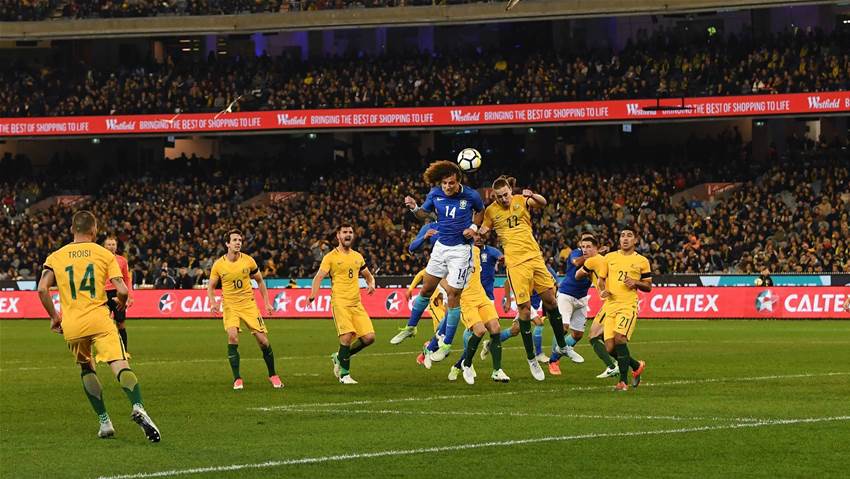The error-prone Socceroos were soundly beaten 4-0 by possession-hungry Brazil while close to 50,000 spectators watched on as preparations for the Confederations Cup were completed.
The world’s highest-ranked national team showed their class, pouncing on Socceroo errors to put four unanswered goals past Mitch Langerak, who was undeniably kept busier in the second half than in the first.
Formations
Ange Postecoglou made eight changes to the starting XI that began the match against Saudi Arabia, after having made several comments in the build-up suggesting that this match would be viewed as a competitive opportunity for players to get minutes on the pitch before next week’s Confederations Cup in Russia.
Tomi Juric, Aaron Mooy, Tom Rogic and Jackson Irvine were all named on the bench, with Massimo Luongo and Aziz Behich coming in as well as Robbie Kruse and James Troisi, who often rotated positions. Injured skipper Mile Jedinak, who has been ruled out of the coming month, was replaced in midfield by Mark Milligan, with veteran Tim Cahill coming in to take the armband. Bailey Wright started ahead of Ryan McGowan, and Mitch Langerak was given another opportunity in goal.
A star-studded Brazil line-up was headlined by Liverpool’s Phillipe Coutinho and Premier League winner David Luiz, with goalkeeper Alves being the first pick ahead of Mat Ryan at Valencia. Alex Sandro, who played for Juventus in their Champions League final loss just a few weeks ago, started at left-back with Bayern Munich man Rafinha on the opposite flank.

Australia’s use of pressing triggers
Aside from a disastrous opening 30 seconds, when Bailey Wright played the ball straight to Giuliano who took full advantage and set up Souza to open the scoring for Brazil, it could be said that Australia defended impressively, especially considering the recent criticism surrounding that aspect of Postecoglou’s system. Especially evident was the use of pressing triggers to guide defensive movement. A pressing trigger provides a reference point for a defending team’s players to initiate a defensive movement, such as a press or withdrawal. The trigger itself can come in a variety of forms, but can commonly be seen as a pass to a specific player, or when a player in a designated position receives the ball. In the situation illustrated below, the trigger was when the ball was passed from the centre-back to the full-back, in this case Rafinha.

As the ball was travelling to Rafinha, Cahill pressed diagonally from Silva in order to cut off the return option whilst Troisi arrived to put pressure on the right-back’s first touch. The opposite central attacking midfielder, Robbie Kruse, tracked the supporting run of David Luiz; it is important to note that at most times during the match, the central attacking midfielder opposite to the ball would pick up this run, leaving the other free to press the ball. The two holding midfielders would mark Brazil’s advanced players, and Behich dropped to pick up right-winger Giuliano. This left Rafinha with very little options on the ball, and the orchestrated press often resulted in a turnover of possession in advanced areas of the pitch or a long ball forwards.
Due to the high success rate of this trigger, the Socceroos stood off the Brazilian centre-backs, even allowing them to play between themselves repeatedly without intervention. It is quite likely that Brazil would have much preferred this, as it would have afforded them the opportunity to play through the lines of pressure much more easily. Pressing on the sides of the pitch has the obvious advantage of the sideline, which effectively restricts the passing range and mobility of the player on the ball.
Three lines of pressure
As seen below, Australia employed three distinct lines of pressure – against Saudi Arabia last week, the two holding midfielders were often pulled further up the pitch, resulting in only two localised (as indicated by the shaded area) defensive lines. In theory, the more lines of pressure there are, the greater the number of passes to escape the press. For example, if there was only one line of pressure, which is a key indicator of a poorly organised pressing scheme, a player can receive a pass from behind the defender and be clear of the press.
Conversely, if there are three lines of pressure, a player must either make a difficult pass to break more than one line at once, or string multiple passes together to break the block by receiving the ball between the lines. However, a balance must be struck between the sheer number of lines and their depth, i.e. the number of players per line. Postecoglou found this balance nicely, as the Brazilians often failed to find a way through, particularly in the first half.

However, on occasion either full-back was not closed down quickly enough and was allowed enough space to avoid the press completely with an aerial switch of play. Later in the game, the higher positioning of left-back Alex Sandro allowed Brazil to bypass several layers of the initial press, and forced Australia to begin defending in a deeper area.
Brazil’s asymmetrical playing system
Any viewer was able to see the technical quality of the Brazilian side, with several one-touch passes avoiding Australian pressure, but it was their ability to create numerical superiority in high areas of the pitch which caused problems for the Socceroos defenders. This was engineered with the assistance of an asymmetrical playing system, meaning that the strategy employed down the left flank was different to that employed down the right. When executed correctly, asymmetry adds variability to a team’s attacking movements, and will often remain undetected by the opposite team for some time. Tite, the mastermind of this approach, was able to utilise the strengths of his team in the most optimal way possible by moving the more talented, creative players towards the middle of the pitch where possible.

The rotation on the left-hand side, as shown above, seemed to be geared towards moving the highly technical Costa inside as well as allowing Alex Sandro to attack. When the ball was in possession of a member of the back four or a deeper midfielder, Coutinho would initiate the move by dropping off from his higher position towards the ball carrier. Generally, Massimo Luongo followed him and was dragged away from his position, meaning that as Coutinho moved away, space was left behind him. This space was filled by Costa, who followed suit by moving medially from his outside position.
This movement effectively added an extra midfielder, and allowed the Brazilians to combine in advanced areas of the pitch. As soon as Costa had moved inside, Alex Sandro provided the width and overlapped, filling the hole that was previously left and completing the rotation. Coutinho would then turn and face his immediate defender, or play to a teammate already facing forward, and the attack would begin again – but this time with more numbers ahead of the ball.

Brazil’s tactical approach on the right-hand side was completely different to the left. Right-back Rafinha did not overlap anywhere near as much as Alex Sandro, but instead played a vital role in providing an option for retreating midfielders to play, as well as feeding right-winger Giuliano. Unlike Costa, Giuliano stayed wide during build-up play and was positioned high up the pitch in an effort to spread the Australian lines of pressure.
At this point, it is important to note that the field of play can be categorised into three main areas; the central zone, the half-spaces and the wide channels. Paulinho was situated in the right half-space, deeper and on an angle to Giuliano. His main role in possession was to be in a position to receive the ball facing forward from Giuliano, and then begin a new attack. This was achieved in many ways, as Paulinho often received the ball between the lines, allowing him to drive at the immediate defensive line and distort their shape. This led to several good opportunities for Brazil, and was an adequate balance for the left-hand side.
Brazil’s patient build-up
Brazil’s approach to the construction phase of possession was one of patience and control. On many occasions, the ball would be played back from advanced positions into deeper areas of their own half, inviting pressure from Australia. The results of this, especially in the second half, were justification for those who hold to playing out from the back as a tactical concept. By inviting pressure onto themselves from the aggressive Australian press, Brazil were able to play through the lines of pressure – whether over or around – and exploit the space left behind. When effective playing out is combined with skilful and pacey dribblers, a rapid transition between construction and chance creation can occur, which fashioned multiple goal-scoring opportunities for Brazil.
Conclusion
A tight defensive performance in the first half by the Socceroos was undone in the second stanza by the pronunciation of Brazil’s asymmetric playing system, which created instability within the Australian defence. When this was combined with the punishment of individual errors on the ball, Tite’s team thoroughly outclassed Ange’s Socceroos. With Germany being next on the horizon, Postecoglou will be hoping for a better response in a match against similar high quality opposition.
Related Articles

Socceroos midfielder embraces move to England

Cardiff City snap up sought-after Socceroos starlet













